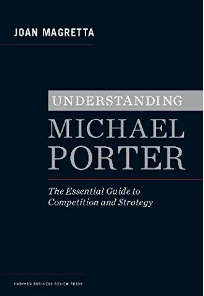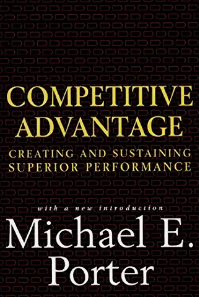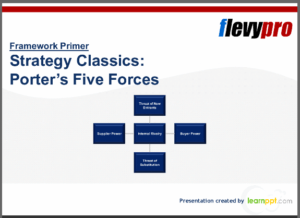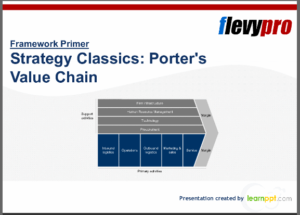Michael Porter of Harvard has developed a model for the competitiveness of industries among nations. Considering international variables is useful to governments, investors, strategists and project management pros.
The post reviews Porter’s Diamond Model and provides some examples of the principles. Finally it offers ideas how PM professionals can use it to be more effective at portfolio, program, and project management.
What Is the Diamond Model by

The Diamond Model by Michael Porter models a nation’s competitive advantage against other nation’s in international markets. The model is also known as the Porter Diamond Theory of National Advantage.
The following are some observations about the factors, structure, and thinking behind the model.
- States that businesses advantages among nation’s result from several clear factors – Those factors – four of them – are shown in the Diamond Model diagram above.
- Provides a structure for thinking about advantages that one nation has over another – It also provides a structure for building an advantage, if one does not exist, and strengthening and extending other natural advantages.
- Useful in thinking about positioning in international trade – whether on a national basis or from the viewpoint of a national competitor.
- Helpful for government policy – This is indicated by the two supporting factors included in the model. Those factors – Government and Chance – indicate that Government can play a key role in facilitating competitive advantages. It can also help to manage risks by enacting policies that reduce risks when Chance events happen.
I believe that Porter’s Diamond Theory also applies regionally, as different region’s within countries tend to build competitive advantages against other regions and other countries, just as nations do on an international scale.
You can get right to the core of Michael Porter’s thinking in his two seminal books, “Competitive Strategy” and “Competitive Advantage“, as well as “Understanding Michael Porter” by Joan Magretta.
And of course there are more excellent Michael Porter books.
 |
 |
 |
Firm Strategy, Structure, and Rivalry
 This first factor has a great deal to do with the benefits of having a high intensity of industry competition in the country.
This first factor has a great deal to do with the benefits of having a high intensity of industry competition in the country.
Here is how this factor works:
- Heavy competition in home market – There needs to be a natural occurrence of domestic industry competitors within the country’s own market. This in turn helps the competitors to compete against companies in other countries where the competition is less intense, as they will be accustomed to competing intensely and are likely to bring better offerings to the marketplace because of it.
- High intensity of rivalry – When this exists, domestic competitors will naturally force each other to a higher level of performance. They will constantly push each other to innovate and improve. It will show up in more innovative products and more efficient operations.
An example of this is Germany, which has three major automobile manufacturers. With BMW, Mercedes-Benz, and Volkswagen, it has substantial rivalry and competitive environment within the country. This can influence each of these competitors to be better performers on the world stage.
Demand Conditions
 The second factor is for the country to have sufficient Demand Conditions to support a given industry within its borders. Good Demand Conditions require the following:
The second factor is for the country to have sufficient Demand Conditions to support a given industry within its borders. Good Demand Conditions require the following:
- Demand in the local market – To sustain a healthy domestic industry, there must be good local demand for the products. Domestic competitors must not be totally dependent on international sales, and must derive benefit from competing domestically.
- Demanding customer base – That local customer base must be demanding. Competitors will only produce the performance required by customers, and this will set the level of performance offered internationally.
- Growth and growing demand – Demand conditions must have enough growth to push the boundaries of performance in production, sales and marketing, quality, and all other factors of competition.
An example of good Demand Conditions is the Belgian beer industry. There is strong local demand for beer, and of high quality by any measure. This propels the industry to equal or surpass the quality of offerings on the international stage.
Related and Supporting Industries
 This third factor refers to the developed infrastructure within the country that further strengthens competitive advantage.
This third factor refers to the developed infrastructure within the country that further strengthens competitive advantage.
The following are three aspects of this infrastructure to consider.
- Partnerships – With a critical mass of industry participants within the country, partnerships among different players can develop.
- Alliances – Similar to partnerships, alliances among in-country industry players also have a chance to develop.
- Suppliers – A substantial supplier network for the industry should develop. The industry ideally will be self-sustaining within its borders.
Each of these aspects of Related and Supporting Industries further strengthens a country’s ability to compete internationally in the industry. This contributes to the effectiveness of, for example, of the German auto industry.
Factor Conditions
 This refers to the availability of different types of resources and conditions in certain countries.
This refers to the availability of different types of resources and conditions in certain countries.
Here are some Factor conditions to have domestically that heavily contribute to national strategic advantage.
- Natural resources – The country has substantial reserves of raw materials, such as minerals and other mined products. This can also include non-extractable resources, such as weather and proximity to navigable waterways.
- Labor – Advantages can be in any and all classes of labor – skilled, unskilled, and/or specialized
- Advanced factors – There are many other factors that can influence and enhance a country’s strategic advantages. Commitment of people to effort and investment is a key factor. Presence of a natural advantage can point to the potential to earn other advantages. Commitment to retain advantages is important. Other factors include orientation to growth and development.
Many countries have natural resources, such as fossil fuels, that provide an advantage for certain industries. However, some countries do not realize those advantages fully because of other factors. If they do realize them, they can enhance them with, for example, downstream development of industries that depend on those resources, such as chemicals.
Two Supporting Factors in Michael Porter’s Diamond Model
There are two indirect, or supporting, factors shown in Porter’s Diamond Model.
Government
- Catalyst – Develop and maintain the needed overall conditions for doing business in targeted industries.
- Ecosystem – Robust infrastructure, education, health care are needed to nurture and support the industry.
- Industry health – Support and encourage productive rivalry and fair practices among competitors through appropriate policies.
- Demand conditions – Facilitate conditions that create strong demand for specific products and services.
Chance
- Uncontrollable external influences – Manage risks such as to be prepared for the inevitable, flexible in the face of the unforeseen, and positioned to see and take advantage of resulting opportunities.
We have certainly seen many situations where governments played a positive, or negative, role in the competitive advantages of their countries.
—————————————-
Do you need some professional slides for a presentation on this or related strategic topics? I suggest the flevy Marketplace for Business Best Practices, and consider these particular Michael Porter documents:
| Strategy Classics: Porter’s Five Forces (28-slide ppt) – $25 | Strategy Classics: Porter’s Value Chain (23-slide ppt) – $25 |
—————————————-
Porter’s Diamond Model and Project Management
The Diamond Model provides a broader perspective of how an industry might evolve. It extends Porter’s Five Forces Model to an international and geopolitical level.
—————————————-
I recommend these PM templates (paid link):
—————————————-
Consider some questions that project managers might ask, and where the Diamond Model might help.
- Portfolio Managers – Are certain countries, and therefore certain projects, subject to greater risk due to the competitive situation? Is the portfolio diversified across countries that have appropriate advantages and risks? Can certain projects be positioned better in one country over another due to inherent advantages?
- Program Managers – Is my program dependent upon any distinct national advantages? Are these advantages vulnerable in some way? What risk management measures can be undertaken to control international risks?
- Project Managers – Are there drivers behind my project based on a national advantage? Is my project in any way at a disadvantage due to national strengths and weaknesses? Are there resources strengths of nations that I can leverage on my project?
For a deep dive into Michael Porter’s thinking, see his two seminal books, “Competitive Strategy” and “Competitive Advantage“. I also recommend a shorter and well written book, “Understanding Michael Porter“, by Joan Magretta.
And of course there are more excellent Michael Porter books.
 |
 |
 |
For more perspective, see the post on Michael Porter’s presentation to the PMI on strategy and project management.
—————————————-
Do you need some professional slides for a presentation on this or related strategic topics? I suggest the flevy Marketplace for Business Best Practices, and consider these particular Michael Porter documents:
| Strategy Classics: Porter’s Five Forces (28-slide ppt) – $25 | Strategy Classics: Porter’s Value Chain (23-slide ppt) – $25 |
—————————————-



1 thought on “The Diamond Model by Michael Porter”